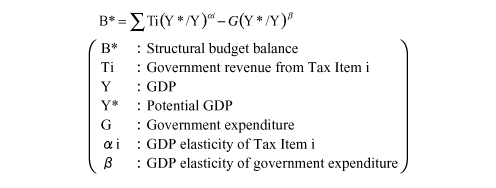Appended Note 3-1 Estimation of Structural Budget Balance
- Japanese
- English
1. Basic Concept for Estimation of Structural Budget Balance
In order to exclude economic cycle factors from the actual fiscal balance, we first assumed that a fiscal balance under which the economy achieves potential GDP does not include economic cycle factors. Potential GDP here is determined as output that average labor and capital in the past can sustain, as described in Chapter One. We took GDP elasticity of the past tax revenues and government expenditure into account here and calculated the structural budget balance as a gap between government revenues and outlays under which potential GDP is achieved. We used the calculated value to produce the cyclical budget balance first and the structural budget balance then with the method as described below:
The above concept is represented by the following equation to determine the structural budget balance:

The above equation is rewritten as follows to indicate that a gap between net government revenues and expenditure corresponding to a GDP gap is a cyclical budget balance that is excluded from an actual budget balance to determine a structural budget balance. Therefore, an actual budget balance can be confirmed as the combination of the structural balance and the cyclical balance.

2. Specific Method for Estimation of Structural Budget Balance
(1) Potential GDP (Y*) (see Appended Note 2-2-3(3)) is used to calculate the GDP gap.
(2) The following GDP elasticity figures for government revenues and outlays are used:

Note: For elasticity figures, see Economic Research (December 1999, No.8, p. 95) by the Economic Research Institute of the Economic Planning Agency.
Sources
Annual Report on National Accounts (FY 2001)
Budget balance: balance of saving and investment (general government)
Corporation tax: income tax (non-financial corporations) + income tax (financial corporations)
Income tax: income tax (household)
Indirect tax: tax on production and imports (general government)
Social security contributions: social contributions (general government)
Unemployment insurance: employment insurance (transfers from general government to households)
3. The following assumptions for FY 2000 and 2001 are used for estimation:
(1) For FY 2001, nominal GDP growth is assumed at minus 1% and real growth at zero. Tax on production and imports, and current tax on income, wealth, etc. are estimated under the above assumption, based on the FY 2000 general account settlements and the FY 2001 revenue projection.
(2) Government final consumption and gross fixed capital formation data for FY 2000 are from the quarterly estimates. FY 2001 data are estimated based on the FY 2000 data and the quarterly estimates for April-June 2001.
(3) Current account balance, capital account balance and other data are estimated in accordance with trends for the past decade.
